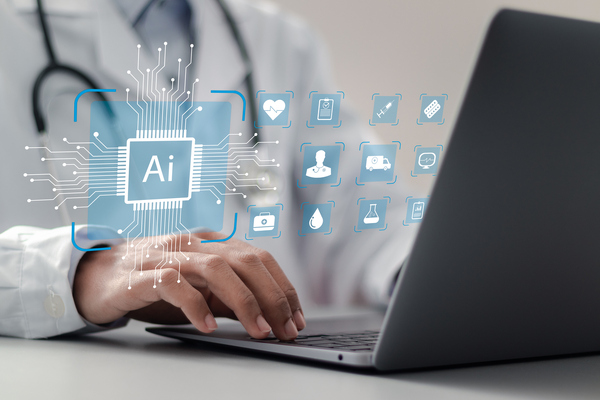The overlooked solution to dermatology’s biggest challenges
Sponsored by Open MedicalNHS dermatology services are using AI to address their challenges, but real progress depends on fixing foundational inefficiencies first

Dermatology services in the NHS are facing mounting challenges, but they’re looking to the wrong technology for help.
Every year, they receive around half a million urgent referrals for suspected skin cancer, yet only 6 per cent of those cases turn out to be genuine. With severe understaffing and an overwhelming number of patients, dermatologists are struggling to meet the nationally mandated 28-day diagnostic window. So many are turning to AI, hoping it can boost efficiency by quickly identifying which patients need specialist care and which can be safely discharged.
But that isn’t the problem. Consultant dermatologists can easily determine whether a lesion is cancerous. The real challenge is collecting all the information they need to make that decision.
Dermatologists need specific information about a patient before making a decision on their care. This includes the GP’s findings, the patient’s medical history and the appearance of the lesion, as well as a dermoscopic image, which uses polarised light to see beneath the skin’s surface in microscopic detail. But gathering all this information takes time, and referrals often miss critical details or are overloaded with irrelevant data. Without the necessary information, remote decisions become unsafe, so patients need to come in for face-to-face appointments. And that process – gathering information, documenting it, explaining it to the patient – takes around 20 minutes per case.
With the growing demand, this model of care isn’t sustainable anymore. And while AI might help reduce the number of referrals, it doesn’t solve the core issue – inefficiency in gathering the right information – and its cost-effectiveness remains unclear. So, AI alone isn’t the answer.
What if, instead, you could streamline the information-gathering process so dermatologists can focus on the decision-making? This approach would tackle the operational inefficiencies within suspected skin cancer pathways. But it requires rethinking models of care to make them more efficient and beneficial for everyone involved. That’s where teledermatology comes in, offering a cost-effective solution with real impact.
Several NHS trusts have already found success through this approach by implementing Pathpoint eDerma, a cloud-based software from Open Medical that supports tailored teledermatology services.
For example, three NHS trusts established a community-based care model using eDerma. Previously, these trusts struggled to manage high patient volumes. Due to the large geographical area, patients often had to travel very long distances to hospitals to have their images taken, only to be called back for in-person consultations because of poor referral quality.
Now, with eDerma, patients can have images of their skin lesions taken closer to home. GP referrals are supplemented with digital questionnaires that patients fill out themselves, providing a more complete medical history. All this information is sent directly to dermatologists through eDerma, improving the quality of referrals. This allows dermatologists to make faster, more confident decisions remotely. Only patients who truly need face-to-face consultations are called in, making care delivery far more efficient.
The results speak for themselves. One trust, which previously met the 28-day Faster Diagnostic Standard (FDS) for fewer than half of its patients, now meets the standard for all of them. Across the three trusts, most patients are diagnosed within 28 days despite an 88 per cent increase in skin cancer referrals. The average time from referral to diagnosis has been reduced by 14 days, and dermatologists are now making decisions within five minutes instead of 20, quadrupling their capacity.
The financial benefits are just as impressive. While reshaping a care pathway might sound expensive, the reality is quite the opposite. On average, diagnosing a skin lesion through eDerma costs £45 less per patient than the traditional approach, and that’s after accounting for all costs, including the platform itself. One Integrated Care System is even projected to save over £1.2 million in its first year alone.
The success of eDerma at these trusts proves that when you use technology to address foundational inefficiencies, the benefits are undeniable.
The challenges facing dermatology services mirror the broader issues within the NHS – staff shortages, rising demand, tight budgets and inefficient processes. Many care delivery models in the NHS simply aren’t designed for the needs of modern healthcare. To address these challenges, technology must be used to build strong foundations and optimise care services. Without addressing the operational inefficiencies, even the most high-tech solutions, such as AI, won’t bring lasting change.
The solution lies in leveraging technology to strengthen care models, laying the groundwork for everything else to follow.
Interested in learning more about Pathpoint eDerma? Click here.
By Charline Hendrickx, Healthcare Content Executive, Open Medical

Business Reporter Team
Most Viewed
Winston House, 3rd Floor, Units 306-309, 2-4 Dollis Park, London, N3 1HF
23-29 Hendon Lane, London, N3 1RT
020 8349 4363
© 2025, Lyonsdown Limited. Business Reporter® is a registered trademark of Lyonsdown Ltd. VAT registration number: 830519543





